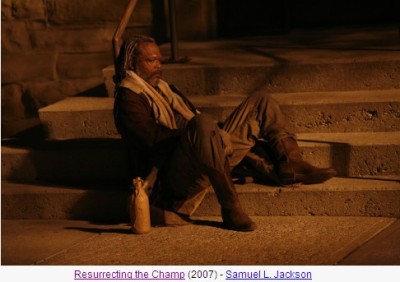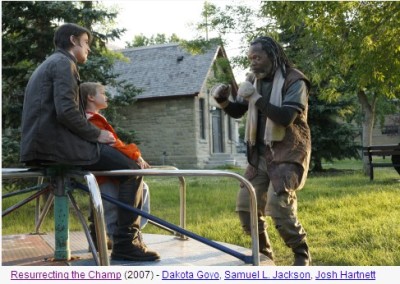By: debbie lynn elias
Battling Bob Satterfield coulda been a contender. Not only could he have been, he was. The Ring magazine ranks him at #58 among boxers as being one of the “greatest punchers of all times”. Mohammed Ali isn’t even on the list. A Chicago City Golden Gloves champ by 1941 at age 22, heavyweight Satterfield was at his peak in the 1950’s going toe-to-toe against the likes of Jake LaMotta and Max Baer and was even a sparring partner for Rocky Marciano. When he hung up his gloves after defeating Howard King on November 21, 1957, Satterfield’s record was 50-25-4, with 35 of those 50 wins by knockout. And then, he quietly disappeared from the sport, from his family, from life, becoming a shadow of a man, a forgotten ghost of Christmas past until 1997 when Pulitzer Prize winning LA Times writer J.R. Moehringer literally stumbled over a man called “The Champ”. Finding a man who was down on his luck but still not out of the game, Moehring found a common thread between himself and Satterfield and set out to not only tell Satterfield’s story in a poignant piece entitled “Resurrecting the Champ” but to also use the experience as his own catharsis or as Moehringer called it, “my 180-pound Moby Dick.” The end result was a moving story not just about a man, but about fathers and sons, relationships, respect, honor and integrity.

On reading Moehringer’s article in 1997, director Rod Lurie, then a journalist and critic himself, knew he had to bring this story to the screen. Proving that patience is a virtue, now ten years later Lurie, together with writers Michael Bortman and Allison Burnett, gets his own shot at the title with RESURRECTING THE CHAMP, based on a true story (but with names and places changed to protect the innocent and to add a little movie magic).
Denver Times sports writer Erik Kernan has spent his life in the shadow of his now deceased famous father, sports announcer Erik “The Wildman” Kernan. Using his father’s fame and his own perceived inability to live up to that name as an excuse for mediocrity, Erik longs to equal the greatness of his father, but as continually told by his editor Metz, “I forget your pieces when I’m reading them. With 192 bylines, I see a lot of typing but no writing.” Sadly, Metz sees Erik’s talent. He also sees that Erik isn’t putting forth any effort to achieve the greatness he has within. And of course, rather than follow Metz’ fatherly advice, Erik looks for the easy way out, the quick way to make a buck and achieve fame. Fame is so important to Erik as he sees it as the only way for his son to be proud of him, a son that he fabricates stories to in order to seem important and be looked up to. But then something changes.

After covering a boxing bout at the local arena, Erik stumbles onto a scraggly, unkempt, homeless old man being beat up by local hot shots. Initially fascinated by the old man’s technique of bob and weave and the power in his punches, Erik intercedes, coming to the man’s aid. Imagine Erik’s surprise when he learns this is “The Champ” – Battling Bob Satterfield, a man long thought and rumored to be dead. Why, he remembers listening to his dad call a Christmas fight of Satterfield’s on the radio. Seeing Satterfield as his own title shot, an answer to his prayers, Erik schemes to write Satterfield’s story. He will bring The Champ out of the shadows. He will resurrect the champ. But the cost of resurrection is never cheap. Himself bobbing and weaving with Metz, the publishing world and his own son, Erik is forced to come face to face with his own shadows and his own need for resurrection and redemption.

This is Samuel L. Jackson’s Oscar gold. According to director Rod Lurie, “This is his Ratso Rizzo.” As The Champ, Battling Bob Satterfield, Jackson is golden. A former boxer at age 19, he embodies the character – physically, vocally, the stance, a boxing shuffle. For his stilted voice, Jackson drew on that of his own grandfather. But according to Jackson, “It was more incumbent upon me to tell this guy’s life story and to get you involved in it and to believe it as much as I needed Josh’s character to believe it.” Jackson is so mesmerizing and so convincing as Satterfield that it is impossible to take your eyes from the screen. In contrast to the character’s outward appearance of vagrancy and desolation, his eyes are vibrant, alive and expressive. The delivery is quick, quick-witted with a heartfelt sincerity. Jackson’s first impression on reading the script was “This is a nice story.”
Josh Hartnett dons his gloves as Erik Kernan. The most emotionally complex character of his career, he has a nice meld of good, bad, conning and deceit, giving way to a very textured and layered character. According to Hartnett, “It’s a very real look at this guy’s life.” Getting to know J.R. Moehringer and his life and livelihood was crucial to Hartnett’s portrayal. “I [even] learned how to type. Got the Mavis Beacon typing and brought it home.”
A small but pivotal role, Alan Alda brings a depth and fatherly tone to Metz and the film. He sets the tone early on with his own patented brand of calm and strength. As the catalyst that pushes Kernan towards dreaming the big idea and Kernan’s ultimate conniving method of achieving that dream, as with Jackson’s Champ, Alda’s Metz is the conscience that Kernan’s own father wasn’t around to provide. Although limited in screen time, Alda’s soft spoken yet firm guiding hand is a welcome balance. Selective in his roles at this stage of his life, “I work if I’m interested in the material and in the script. This interested me. If it’s not a movie that I wouldn’t go see myself, then I won’t do it. If there’s anything hard about the part or that makes me wonder if I’ll be ale to do it, that’s another reason to do it because that’s how I’ll get better.”
Another noteworthy appearance comes from Harry Lennix who plays Satterfield’s estranged son. Lennix, who worked with Lurie on “Commander in Chief” was at the top of Lurie’s list for this part. Again, a small but integral structural role. David Paymer is stunning as magazine editor Whitley. And relative unknown Glenn Hunter is a dead ringer for a youthful Rocky Marciano.
Written by Michael Bortman and Allison Burnett based on Moehringer’s 1997 article, the result is a smart, well crafted, touching and poignant story. Ripe with multi-textural characters and interpersonal relationships, there is great exploration into conscience and integrity and parental relationships, striving for acceptance and pride from both generations, sharing experiences or missing those shared experiences. Key to the heart of the story is the hero worship between fathers and sons and the desire to “embellish” the truth a little or a lot but at the end of the day, the watchwords are truth and honesty. In watching this film, I was reminded of my dad and my grandfather. Not the most sports savvy person in the world (many years ago during the IVB Golf Classic my dad announced that Arnold Palmer was on third base, so you get the picture), the one sport that I remember seeing my dad and grandfather watch together were the fights, the Saturday night fights. Be it for pugilistic thrills or merely the fact that a common average person can always “put up his dukes”, boxing has long been a father-son (or father-daughter) ticket which is a commonality that serves this film and story well. I first took note of director Rod Lurie with “The Last Castle”. His precision and meticulous detail and pacing were riveting, complimenting exemplary performances of a cast heralding Redford and Gandolfini. His work with “Commander in Chief” also set a compelling standard of excellence and intensity. Drawn to the human element of the story, with RESURRECTING THE CHAMP, Lurie not only captures the essence and vibrancy of the sport of boxing with impeccably choreographed flashbacks, he achieves the look and feel of a newsroom and the newspaper business with an authenticity undoubtedly due to his being able to shoot in an actual newspaper during working hours. With a story set in Denver, Calgary was a more than adequate substitute for shooting, although during the only 2 days of shooting in Denver, Lurie did get to catch a pass from John Elway (who has a cameo). Bringing characters and relationships front and center, Lurie’s heartfelt sensitivity and intense approach at times makes one forget about the boxing or poverty or Kernan’s columns, and eloquently focuses your attention on the men, the fathers, the sons – those absent and present.
Maintaining his standard of excellence, Lurie brought in only the best, like boxing choreographer and stunt coordinator Eric Bryson, a former sparring partner of Lennox Lewis. Relying on Bryson’s experience and keen eye, it fell to Bryson to cast the various fighters “from days gone by.” A real casting coup is Jake La Motta himself making a “phone appearance.” Bryson called on Olympic boxer and Canadien Cruiserweight Champion Troy Amos Ross to play the young Satterfield. Particularly impressive to Bryson was that Sam Jackson was able to mimic Ross’s style and memorize a fight sequence with one shot. Cinematographer Adam Kane enhances the stellar story and acting with substantive, methodical and at times gritty camerawork.
To Lurie, this is a movie about fathers and sons which just happens to have boxing in it. “This movie is about all sorts of fathers and sons. And the power and the beauty of it and all that you require to make that connection work is to simply tell the truth. That’s all it takes.”
With RESURRECTING THE CHAMP the truth is quite simple. It’s a knockout.
Samuel L. Jackson – Bob “The Champ” Satterfield Josh Hartnett – Erik Kernan Alan Alda – Metz
Directed by Rod Lurie. Written by Michael Bortman and Allison Burnett based on an article by J.R. Moehringer. Rated PG-13. (111 min)












